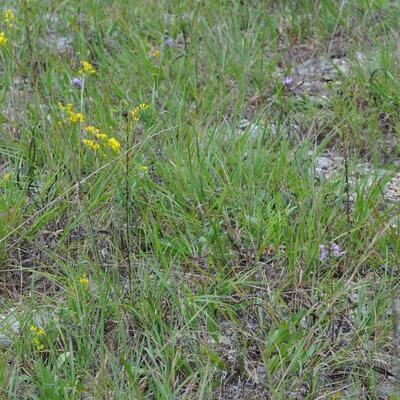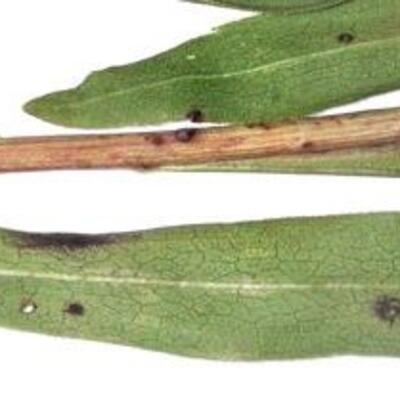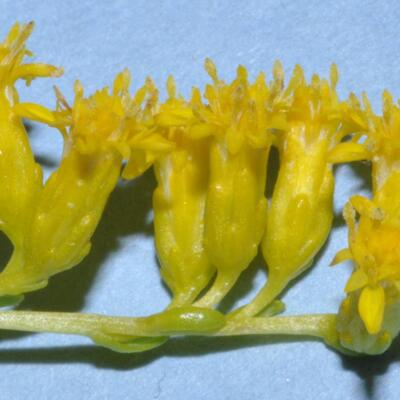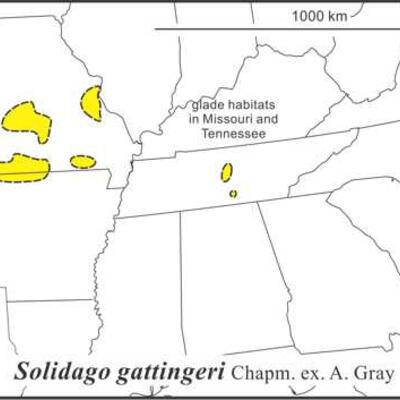Department of Biology
ESC 350
200 University Ave. W
Waterloo, Ontario, Canada N2L 3G1
Phone: (519) 888-4567 ext. 32569
Fax: (519) 746-0614
Gattinger’s Goldenrod
Solidago gattingeri Chapman ex A. Gray is native to cedar barrens, limestone ledges and glades in central Tennessee, southern Missouri and adjacent Arkansas. It is adapted to seasonally dry habitats and can have shiny stems and leaves and phyllaries. The species has 5–8 ray florets and 3-9 disc florets (Semple & Cook 2006 FNA). In a multivariate study, Lopez Laphitz et al. (2011) found the S. gattingeri, S. juncea, and S. pinetorum differed from the western three species of subsect. Junceae (S. confinis, S. guiradonis and S. spectabilis), but could be sometimes similar to each other on technical traits. Sample sizes were small and an expanded analysis would be useful. The species is diploid 2n=18 in central Tennesee. Semple (2023) mapped the limited data on the cytogeography of S. gattingeri.
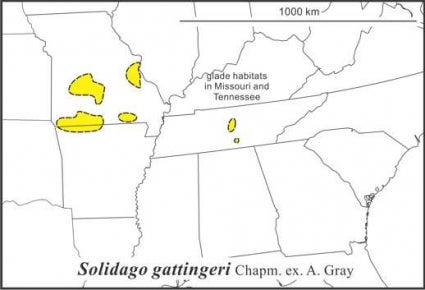
Solidago gattingeri was included in S. subsect. Junceae by Semple and Cook (2006). Semple and Beck (2021) placed it in S. subsect. Radulae following the results of a polygenomic DNA study of Solidago and related genera (Semple et al. 2023 in press).
Solidago gattingeri, glade habitat, Semple et al. 11856, Rutherford Co., Tennessee
Solidago gattingeri, shoot, Semple et al. 11856, Rutherford Co., Tennessee
Solidago gattingeri, rosette leaves, Semple et al. 11856, Rutherford Co., Tennessee
Solidago gattingeri, lower leaves, Semple & Chmielewski 5288, Camden Co., Missouri
Solidago gattingeri, heads, Semple et al. 11856, Rutherford Co., Tennessee
Lopez Laphitz, R., Yunfei Ma and J.C. Semple. 2011. A multivariate study of Solidago subsect. Junceae and a new species in South America (Asteraceae: Astereae). Novon 21: 219-225.
Semple, J.C. and J.B. Beck. 2021. A revised infrageneric classification of Solidago (Asteraceae: Astereae). Phytoneuron 2021-10. 1-6.
Semple, J.C. 2023. The cytogeography of Solidago subsect. Radulae (Asteraceae: Astereae). Phytoneuron 2023-20: 1–12.
Semple, J.C., McMinn-Sauder, H., Stover, M., Lemmon, A., Lemmon E., and J. B. Beck. 2023 in press. Goldenrod herbariomics: Hybrid-sequence capture reveals the phylogeny of diploid Solidago. Amer. J. Bot. 110: xxxx-xxxx.
Revised 10 July 2023 by J.C. Semple
© 2023 J.C. Semple, including all photographs unless otherwise indicated
